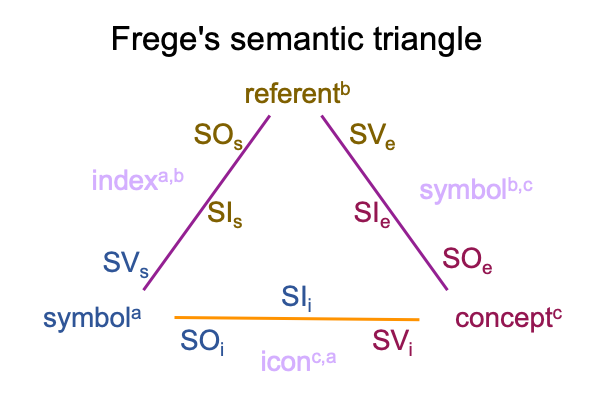1204 In section 18.4, titled “Anchors of Meaning: External Semiotic Representation and the Disembodiment of the Mind”, explores the interventional sign-relation, without knowing what the interventional sign-relation is.
Instead, the author frames a discussion in terms of current research into cognitive niches.
An external representation (such as a word-gesture in hand talk) can be accessed and modified in different cognitive niches (such as different teams within a band of Homo erectus) because the hand-talk word is anchored as an icon or index of a referent.
In this way, hominins extend their “minds” into the Umwelt and turn it into a Lebenswelt of hand-talk words.
1205 The author labels the use of hand talk words by teams in obligative collaborative foraging, “abduction manipulation”.
The label is as funny as it is true.
If [symbola] images [conceptc], then every interventional sign-relation asks, “Guess what I’m thinking?”
That question is pure abduction manipulation.
1206 For an example, in Figure 18.3, the author offers a diagrammatic representation that calls to mind Aristotle’s demonstration of how the geometry of triangles may be intuitively abstracted.
Even the slaves of ancient Greece can follow the diagram.
Compare that to the following presentation of Frege’s triangle.

The two triangles are not so different. Both manipulate abduction.
1207 The last half of section 18.4 discusses the disembodiment of the mind.
Semiotic agency (purple lines) embodies the mind.
The interventional sign-relation (orange line) is like a mind, disembodied.
Along those lines, there are some late moderns who assert that our current Lebenswelt is a simulation.
I wonder, “Are they communing with the orange line?”
1208 Speaking of communing with orange lions, the author offers a work of Paleolithic art dating to around thirty-thousand years ago. It is orange. But, that is not the salient feature. It’s shape is half-man (bottom portion) and half-lion (top portion).
1209 I wonder, what is the story behind the lion-man Paleolithic artifact?
The Upper Paleolithic of Europe begins after humans evolved (around 200,000 years ago). The continuity between 200,000 years ago and 30,000 years ago is strong, but advances in tool-use, resilience to different ecologies, and creativity in spiritual awareness are remarkable. Spiritual awareness? It’s just another term for “disembodied mind”. That lion-man, carved from ivory and stained orange from years of resting in soil, embodies a “disembodied mind”.
1210 That means that the lion-man is an agent, capable of semiotic agency, and its owner is an agent, capable of semiotic agency.
So, what is the owner up to?
1211 Well, I need to go back more than 170,000 years before the 30,000 year old artifact to explain.
After the domestication of fire, starting 800,000 years ago, hand-talk, once confined to the social circle of teams, becomes an activity in its own right, as cooking becomes more communal (one fire, one cookout per band) and shooting the breeze after a nice meal becomes routine. Hand-talk adapts and becomes linguistic.
Linguistic hand-talk offers an opportunity not available to proto-linguistic hand-talk. One can make grammatically correct counter-intuitive statements. Even though every gesture-word is sensible, because it pictures or points to its referent, when combined to make a grammatically correct statement, a new type of mental construction (or “cognitive space”) becomes possible.
See the chapter of meaning in How to Define the Word “Religion”, by Razie Mah, available at smashwords and other e-book venues.
1212 The figure of lion-man precisely captures the counter-intuitive nature of nonsensical hand-talk statements. The lion part pictures a lion. The human part pictures a human. Each part is perfectly referential. But, the artifact makes no sense at all.
1213 Soon after the the domestication of fire, the Neanderthals and Denisovans speciate as hominins practicing fully linguistic hand-talk. They are not the only hominins that thrive on the fact that the cognitive spaces opened by fully linguistic hand talk are good at organizing all social circles, including very large social circles such as the community (150), the mega-band (500) and the tribe (1500).
These larger social circles cannot gather for long, because large meetings are opportunities for disease. So, they develop cultural practices that are useful for rapid recognition and social synchronization. One of these practices is singing. Singing is a powerful semiotic tool for both recognition and synchronization. Sexual selection for better singing follows. The vocal tract comes under voluntary neural control.
1214. Then, a little over 200,000 years ago, the voice is added to hand talk (as an adornment) with the speciation of Homo sapiens. Hand-speech talk is born, along with the semiotics of adornment. The Paleolithic period that followsslowly discovers what adornment can do. And, equally slowly, the speech aspect of hand-speech talk takes on a life of its own.
Around 50,000 years ago, humans migrate into ice-age Europe. They occasionally breed with Neanderthals. How can this happen? Humans are still predominately practicing hand talk. Their speech is an adornment.
By 30,000 years ago, humans have not bred with Neanderthals for thousands of years, even though many carry Neanderthal genes. Why? Perhaps, the occasional presence of the hand-talking Neanderthals inspire the humans to speak more, to cultivate their vocal adornments by exploring the semiotic capacity of speech in the milieu of hand talk. The Neanderthals cannot speak. They can try to imitate what the humans are doing. But, their vocal tracts are not under the same degree of voluntary control.
Hmmm. Extinction looms.
See Comments on David Reich’s Book (2018) Who We Are and How We Got Here, by Razie Mah, available at smashwords and other e-book venues.
1215 The Upper Paleolithic lion-man is fashioned as an artifact, an agent, with a mind. Obviously, a piece of ivory does not have a mind, so the modern scientist must call what the lion-man exhibits, “a disembodied mind”.
